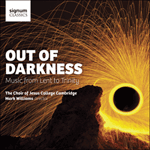Cunctis diebus is in some ways a companion piece to the extended
Infelix ego. Both start with a section for three voices (reminiscent of the old Votive Antiphon) and Byrd even uses a first inversion chord at the cadence before the first choral entry, a nod in the direction of Robert White who had used this startling gesture at the end of the first section of his Lamentations for five voices.
Cunctis diebus is an example of Byrd choosing his words carefully. He uses verses from the famously miserable Book of Job: one verse from chapter 14 and then two from chapter 10. There is nothing positive here and Byrd highlights the darkness with his harmony at the words ‘ut plangam paululum’ (‘that I might lament a little’). Yet in the final section ‘where there is no order, but everlasting horror dwells’, Byrd chooses a rather cool and neutral sound world before a ravishing coda. Perhaps Byrd’s message is that fear of what is to come is unfounded and that the new world is not so terrifying.
from notes by Andrew Carwood © 2010
Cunctis diebus fait comme un pendant au long
Infelix ego. Tous deux s’ouvrent sur une section à trois voix (écho de la vieille antienne votive) et Byrd emploie même un accord à l’état de premier renversement à la cadence, avant la première entrée chorale, un clin d’œil à Robert White, qui avait utilisé ce geste saisissant à la fin de la première section de ses Lamentations à cinq voix.
Cunctis diebus illustre avec quel soin Byrd choisissait ses textes—en l’occurrence, un verset du chapitre 14 puis deux versets du chapitre 10 du Livre de Job, fameusement triste. Ici, rien de positif, une noirceur que souligne encore l’harmonie servant aux mots «ut plangam paululum» («que je pleure un peu»). Pourtant, dans la section finale, «où il n’y a aucun ordre, mais où règne une perpétuelle horreur», Byrd opte pour un univers sonore assez paisible et neutre, avant une ravissante coda. Et voici, peut-être, le message du compositeur: la crainte de l’avenir est infondée et le monde nouveau n’est pas si terrifiant.
extrait des notes rédigées par Andrew Carwood © 2010
Français: Hypérion
Cunctis diebus ist in gewisser Weise ein Pendant zu dem ausgedehnten
Infelix ego. Beide beginnen mit einem Teil für drei Stimmen (was an die alte Votivantiphon erinnert) und Byrd setzt sogar bei der Kadenz vor dem ersten Choreinsatz einen Akkord in der ersten Umkehrung ein, was eine Anspielung an Robert White ist, der von dieser überraschenden Geste am Schluss des ersten Teils seiner Klagelieder für fünf Stimmen Gebrauch gemacht hatte. In
Cunctis diebus wählt Byrd seine Worte besonders sorgfältig aus. Er vertont Verse aus dem bekanntermaßen elenden Buch Hiob: ein Vers aus Kapitel 14 und zwei aus Kapitel 10. Hier ist nichts Positives und Byrd betont die Düsterkeit der Worte „ut plangam paululum“ („dass ich mich ein wenig erhole“) mit seiner Harmonie. Im letzten Teil jedoch „wo Finsternis und keine Ordnung herrscht“, wählt Byrd ein recht kühles und neutrales Klangbild, bevor eine atemberaubende Coda erklingt. Vielleicht ist Byrds Botschaft hier, dass die Angst vor dem, was kommen wird, unbegründet ist und dass die neue Welt nicht so entsetzlich sein wird.
aus dem Begleittext von Andrew Carwood © 2010
Deutsch: Viola Scheffel


 Out of darkness
Out of darkness
